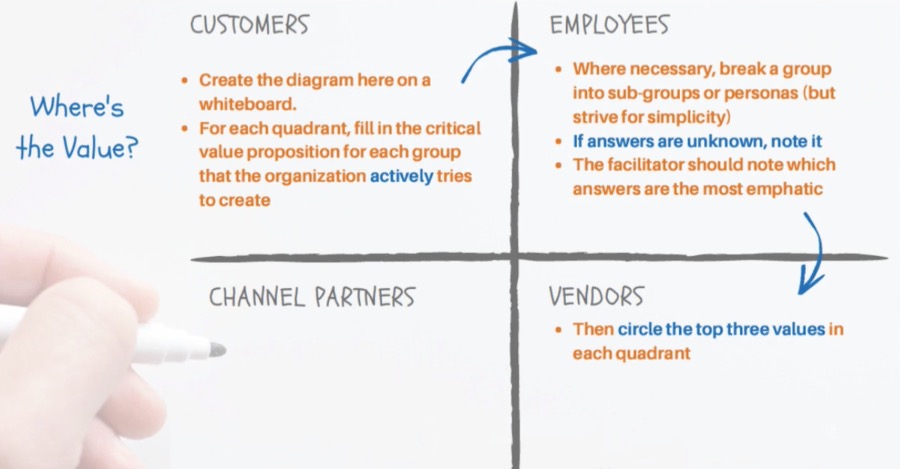Have you calculated your ROE yet? Adam Nathan, C-suite data-strategy whisperer, Olympic-level thinker, and CEO of The Bartlett System, sums up what event execs should be asking of themselves and their teams in order to pull it all together.

Marketing teams tend to get distracted by the daily onslaught digital and creative possibilities. Of course, you already know that ROI is important — but have you considered your Return on Event (ROE)?
Luckily, there’s a useful and familiar classic “Five-Point Business Model” you can leverage in event planning, delivery, and evaluation.
We call this the Event Business Model (EBM). Events have remarkably similar attributes to planning and running any other large-scale, data-driven business — whether an event is your core business or an extension of your business.
They need a plan to define and target the right customers, create the right value (and content) for them, use the correct channels, and manage the right partnerships. They need to mitigate critical friction points while managing a complex, three-sided business model of sponsors, exhibitors, and attendees. And you can’t really look to other companies or events because every participant’s needs are specific to their value proposition.
But First, Why Events? (Because They’re Seriously Trending)
-
According to Forrester, $108 billion is spent on event hosting each year.
-
As reported by Statista, 48% of revenue from large events and trade shows in the U.S. is derived from registration, 21% from exhibit sales, 16% sponsorship sales.
-
For B2B marketers, 67% believe that events are their most effective marketing tool.
-
Two of the largest trade show organizers in the world, Informa and UBM, are discussing a merger and Viacom just purchased VidCon in order to focus on live events.
-
In fact, Tarsus Group, Informa, and UBM all saw profit increases in 2017. The trade show and exhibition industry is also on track for a banner year in 2018.
-
73% of brand marketers say events are essential to doing business and Venture Capital continues to flow into the event industry, along with obligations to stakeholders.
Help with CEO KPI
So, what are the core “business goals” that you are trying to accomplish?
-
Lead generation
-
Client retention
-
Increased verification rates
-
Reduced churn
-
Closed sales
-
Maximizing return on ad spend
-
Learning a new skill/business tactic to implement
-
Training and penetration in existing accounts
-
Building audiences in-between events (You are doing this, right?)
The Attendee, Sponsor, and Vendor Journeys
People often talk about “mapping the attendee journey,” but what about the sponsor and vendor journeys? How does real-time marketing create value in these cases?
And like all businesses today, they need to build and engage audiences online all year round and then convert them into participants in real life at their events. That’s a LOT of touchpoints. Approached from this perspective, your annual event becomes a stand-alone business, and your investor, CEO, and key stakeholders need you to demonstrate that it returns value, year after year, event by event. Your customers need to purchase, avoid churn, communicate with you, and multiply furiously.
In fact, there are few activities, if any, that more closely position a CMO into the role of a CEO, and vice versa. For this reason, the notion of building a “business model” for your event, starting at the C-level, can be a useful framework for structuring the goals of your event and communicating with your creative team.
Define Your Event’s Bottom-Line Business Goals
The revenue-driving business needs for every event should be crystal clear. It’s likely that your organization needs more than just high post-event CSAT scores.
Somehow, some way, the event needs to make a financial impact.
Christopher Korody, a partner with Audience Metrix, gives his take in Bizbash:
“You can have the happiest people in the world at your event, but if you didn’t sell anything, it’s not a successful event and they won’t want to do it again. So, this is why understanding the business purpose has to be a part of developing any kind of measurement program.”
Critically, can you quantify the following:
-
Are your event goals enough to achieve a financial breakeven?
-
What does success look like against your critical goals?
-
Can you financially see your way to the next event while delivering this one?
Consider the Classic Business Model Questions
Once the business goals for an event are locked in, the CMO/CEO can design an EBM with their team.
With this framework set, they should communicate it broadly so that it is part of the evaluation process for every budgetary, creative and technological choice.
Questions to be resolved in your EBM should resemble classic business model questions. Make sure your team leaders are aligned with consistent answers to the following:
-
Who are the target persona groups for attendees, sponsors, and exhibitors?
-
How will we identify and support each group in person and digitally?
-
What is your value proposition for each group?
-
How and where are your event revenue streams generated?
-
What monetization timeframe are your event participants expecting from their investment?
-
How do we measure real-time event ROI for our participants?
How Will I Know I’m There?
When your vision for these questions can be diagrammed on a whiteboard from memory, you’re there.
If you need a PowerPoint deck, you’re probably not there – and your team is even less likely to be there.
But if you’ve gotten this far…
Then you’ve created guardrails and systems that actually empower your creative and marketing teams. This will save enormous amounts of expense, and allow you to focus, prioritize and avoid missed opportunities. They can then concentrate on creating value within the boundaries of a clearly defined playing field.
When you’re ready, check out 818 Agency’s tailor-made guide to Facebook and Instagram advertising for event executives.
What’s Next in This Series?
In the next three parts in this series, we’ll take a structured, sequential look at building on your EBM (Event Business Model):
-
We’ll distill the EBM into a broad class of Key Performance Questions (KPQs).
-
We’ll create metrics that become agreed-upon enterprise measures for success.
-
Finally, we’ll look at aligning different marketing tactics, data-driven or otherwise, to the metrics we care about.





